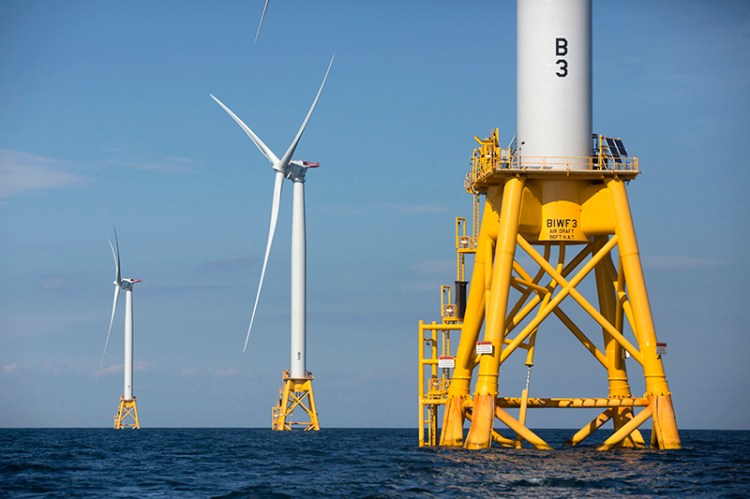BOSTON — Massachusetts and Rhode Island have announced offshore wind projects aimed at delivering a combined 1,200 megawatts of energy, enough to power 400,000 homes.
The Vineyard Wind project will be Massachusetts’ first offshore wind farm and is expected to generate 800 megawatts of energy. That’s about 5.5 percent to 6 percent of the state’s total annual electric load.
State officials said that represents the largest single procurement of offshore wind by any state in the nation. Vineyard Wind was selected by Massachusetts over two other offshore wind proposals: Bay State Wind and Deepwater Wind.
Also Wednesday, Democratic Rhode Island Gov. Gina Raimondo said the state had selected the same Deepwater Wind project proposed for Massachusetts – a 400-megawatt offshore wind farm called Revolution Wind.
Both projects, which the states described as a collaborative effort, will be located south of Martha’s Vineyard.
Massachusetts Gov. Charlie Baker said the announcement brings his state “one step closer to achieving our administration’s goals of creating a clean, reliable and cost-effective energy future for Massachusetts residents, and significantly reducing greenhouse gas emissions to combat climate change.”
The announcement is the result of a 2016 bill that Baker signed authorizing the largest procurement of renewable energy generation in Massachusetts’ history, including about 1,600 megawatts of offshore wind energy. The remaining 800 megawatts will be awarded at a separate time.
Vineyard Wind said it hopes to begin delivering renewable energy to Massachusetts residents and businesses in 2021. The final acceptance of the bid and awarding of the contract is conditional upon successful contract negotiations.
Lars Thaaning Pedersen, CEO of Vineyard Wind, said the decision “reflects the strong commitment to clean energy” by Baker and Massachusetts lawmakers.
According to Vineyard Wind, the project consists of an array of wind turbines, spaced at least eight-tenths of a mile apart, that are each capable of generating over 8 megawatts of power. Vineyard Wind is a joint venture of Avangrid Renewables and Copenhagen Infrastructure Partners.
Deepwater Wind CEO Jeff Grybowski called the joint announcement “the first really large-scale procurement ever for offshore wind in the United States.”
“It means that offshore wind is no longer a growing industry, it really is an industry that’s maturing,” he said.
Local construction on the project could start in Rhode Island in 2020, with 50 turbines operating commercially by 2023. Deepwater Wind already owns the nation’s first offshore wind farm, a five-turbine farm off Block Island, Rhode Island.
The projects are part of a wider push for proposed offshore wind power along the East Coast, with other states – including New Jersey, Connecticut, Virginia and New York – pressing ahead with the goal of transforming the electric grid and providing energy to power millions of homes.
In Maine, Gov. Paul LePage has been a persistent critic of the wind and solar energy industries, suggesting such renewable technologies drive up electricity costs for ratepayers and cannot compete without government subsidies.
In January, LePage imposed a moratorium on new wind energy projects in western and coastal Maine while establishing a secretive commission to study how wind turbines affect the state’s tourism economy. The moratorium would remain in place until a new Maine Wind Energy Advisory Commission – which will have meetings that are closed to the public and not subject to Maine’s Freedom of Access Act – reports on wind power’s economic impact and recommends potential regulatory changes.
Lawsuits filed to overturn the moratorium are still pending in court.
Maine had 378 wind turbines with a maximum generation capacity of 901 megawatts last year, more than all other New England states combined and ranking Maine 21st nationally, according to a 2017 report from the American Wind Energy Association. Although development of wind energy projects has continued during LePage’s tenure, critics accuse the governor of creating an unwelcome environment for an industry that has created or supported thousands of jobs in Maine over the past decade.
In the highest-profile example, Norway-based energy giant Statoil abandoned plans to build a $120 million demonstration wind farm off the Maine coast in 2013 in response to LePage’s involvement. Two years later, Statoil announced plans to build the world’s first floating, deep-water wind farm – an estimated $228 million project – off the coast of Scotland.
The wind advisory commission also could affect the Maine Aqua Ventus project, an experimental floating wind farm off Monhegan Island that would be the first of its kind in the United States. The project is being developed by a consortium led by the University of Maine.
On the West Coast, states are also looking to turn their offshore winds into energy, and U.S. Interior Secretary Ryan Zinke has said he hopes to help streamline the push for offshore wind power.
Emily Norton, of the Massachusetts Sierra Club, applauded the Massachusetts and Rhode Island projects, saying the state should try to procure the remaining 800 megawatts of offshore wind to help the state move toward a 100-percent renewable future.
The Massachusetts Clean Energy Center, a state economic development agency, said the creation of 1,600 megawatts of offshore wind power should create over 3,000 “job years” over the next 10 years. A job year is defined as one person working full-time for one year.
Send questions/comments to the editors.



Success. Please wait for the page to reload. If the page does not reload within 5 seconds, please refresh the page.
Enter your email and password to access comments.
Hi, to comment on stories you must . This profile is in addition to your subscription and website login.
Already have a commenting profile? .
Invalid username/password.
Please check your email to confirm and complete your registration.
Only subscribers are eligible to post comments. Please subscribe or login first for digital access. Here’s why.
Use the form below to reset your password. When you've submitted your account email, we will send an email with a reset code.